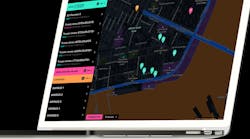The global anti-drone market is growing quickly. In the U.S. alone, this is a $400 million market that is expected to reach nearly $2 billion in five years. Sensofusion is the developer of the AIRFENCE unmanned aircraft system (UAS) countermeasure technology used by military and police, as well as some companies within the private sector. The technology provides the means to detect and triangulate the position of UASs, using computers and mobile devices to show data (see figure). Based on a recent surge in orders, the Finnish- and U.S.-based company has doubled its manufacturing capacity to keep pace with demand for its pioneering drone defense technology.
“Based on our current customers, we have strong reason to believe Sensofusion has the largest network of active counter-UAS sites across the globe,” said Sensofusion vice president Kaveh Mahdavi. “This is particularly interesting because not only does it demonstrate healthy growth, but we’re learning a lot in the process. At its core, AIRFENCE is always improving, but how we improve the customer experience depends a lot on direct feedback from the customer using the technology in their day to day.
Organizations such as the U.S. Marines and the FAA are relying on advanced drone detection and mapping technology such as the AIRFENCE 5.0 system from Sensofusion. (Graphic courtesy of Sensofusion)
“With a rapidly growing user base in a variety of industries,” Mahdavi continued, “including military, private security, and protecting government assets such as utility centers, we’ve been able to focus on the right adjustments that yield the biggest improvements for our end customers.”
AIRFENCE 5.0, the latest version of the counter-drone technology, offers improved performance compared to earlier versions, with new direction-finding (DF) and anti-jamming capabilities, enhanced detection and tracking, and the ability to generate minimal RF footprints to render detection of the system difficult by adversaries. An AIRFENCE system uses software-defined-radio (SDR) technology to detect unmanned aerial vehicles (UAVs) across a 6-mile (10-km) range, with a custom-configured alarm system to provide early detection for operators. Real-time software updates can be performed over the air to keep up with evolving threats.
“In order to meet the demand from the influx of orders, which came in at the beginning of 2018 for our latest version, AIRFENCE 5.0, we’ve had to double the size of our manufacturing capacity,” Mahdavi noted. “We are forecasting 5× growth in revenue for 2018 as the industry matures.”


